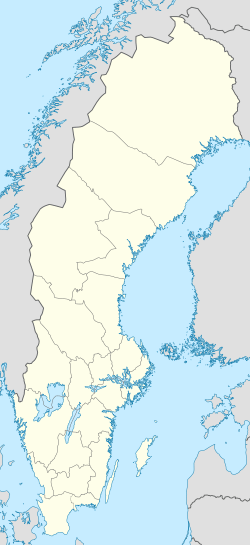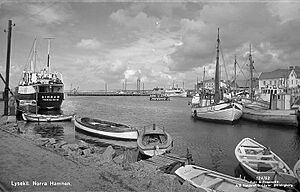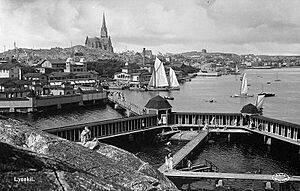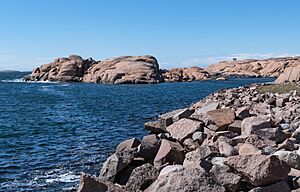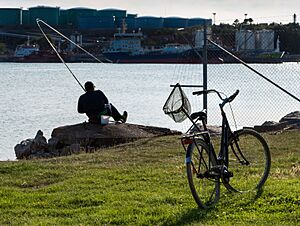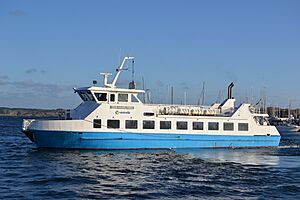Lysekil facts for kids
Quick facts for kids
Lysekil
|
|
|---|---|
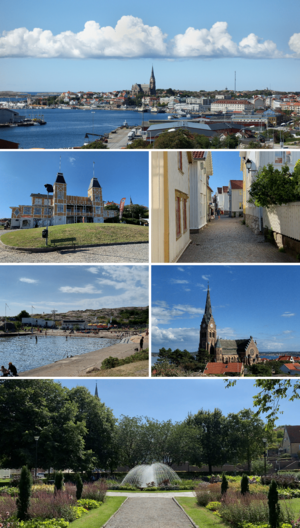
From the top, left to right: Lysekil skyline, the Gentry Salon, Gamlestan, Pinnevik beach, Lysekil church, and the Town Park.
|
|
| Country | Sweden |
| Province | Bohuslän |
| County | Västra Götaland County |
| Municipality | Lysekil Municipality |
| Area | |
| • Total | 3.75 km2 (1.45 sq mi) |
| Population
(01 december 2022)
|
|
| • Total | about 8,000 |
| • Density | 2,032/km2 (5,260/sq mi) |
| Time zone | UTC+1 (CET) |
| • Summer (DST) | UTC+2 (CEST) |
Lysekil (Swedish pronunciation: [ˈlŷːsɛˌɕiːl]) is a town in Västra Götaland County, Sweden. It is the main town of Lysekil Municipality. About 8,000 people live there. Lysekil is located on the southern tip of the Stångenäs peninsula. It sits right where the Gullmarn fjord meets the sea. The town is special because it has two nature reserves.
Lysekil started as a small fishing village. Over time, it grew into a town known for its fishing industries. It also became important for shipping and trade. This happened during the 1700s and 1800s. The Stone industry, using red Bohus granite from local quarries, was also very important until the 1950s. Today, one of Sweden's largest oil refineries, Preemraff Lysekil, is located just outside the town.
In the 1800s, Lysekil became a popular seaside resort and spa. Even today, tourism is a big part of the town's economy.
Contents
History
Lysekil was first mentioned in the year 1570. It was originally part of a larger farm called Lyse. The people living there mostly earned their living from fishing. They also worked in shipping, moving goods by sea. The first settlement was on the north side of the Stångenäs peninsula. This area had a natural, safe harbor. Today, it is known as North Harbor (Norra Hamnen).
In the past, before lighthouses were common, people sometimes lit false fires. These fires tricked ships into crashing onto the shore. Then, people would take things from the wrecked ships. During the Great Northern War (1700–1721), Lysekil was a harbor where the government allowed "privateering." This meant private ships could attack and capture enemy ships. King Charles XII of Sweden needed ships and sailors for his navy. Allowing privateering was one way to get them.
After 1750, herring fishing became very popular. This made fishing businesses in Lysekil grow a lot. The main products they sold were salted herring and "train oil." Train oil was made by boiling herring to get its oil. During the time of sailing ships, Lysekil became a key place for fishing and shipping. By the mid-1800s, the fishing village had many sailing ships. In 1909, 18 large sailing ships and 10 steamboats were registered there. That same year, over 6,800 ships came and went from the harbor.
In the second half of the 1800s, Lysekil became a popular bathing resort. The first warm water bath house was actually made from a ship's cabin! The first proper bath house was built in 1849. In 1859, a doctor named Carl Curman came to Lysekil. He studied the climate and thought Lysekil was perfect for a spa town. Thanks to his connections, Lysekil became a favorite resort for people from Stockholm. New bathhouses, hotels, and parks were built between 1864 and 1890. These were located on the south side of town, now called South Harbor (Södra Hamnen). The two famous Curman Villas were built during this time.
During World War II, Lysekil was part of "Operation Bridford." This was a secret operation where fast ships, called "Blockade runners," broke through German mine blockades. They shipped important ball bearings to England. Later, the same route was used to bring supplies to the Danish resistance movement.
On August 19, 1961, something very unusual happened in Lysekil. A car and a submarine collided! This is the only time such an event has been recorded in history.
Geography
Lysekil is located on the southern tip of the Stångenäs peninsula. This is on Sweden's west coast, at the entrance of the Gullmarn fjord. The town is surrounded by the sea on three sides. Many islands and small islets are also nearby. Some of the larger islands include Stora and Lilla Skeppsholmen, Skälholmarna, and Släggö.
Lysekil has many harbors, piers, and boardwalks along its coastline. The two main harbors are North Harbor and South Harbor. In the North Harbor, you can find Gamlestan (Old Town). This area has old wooden cottages and houses that have been restored. They make the town look very picturesque. Both the north and south harbors have places for guest boats. They also have many restaurants and cafés.
Nature reserves
Lysekil is home to two important nature reserves: Stångehuvud and Gullmarn fjord. The red granite cliffs of Stångehuvud were bought in 1920 to protect them. This was done by Calla Curman. In 1982, the area officially became a nature reserve. These cliffs are at the southwest end of the Stångenäs peninsula. In 1983, Gullmarn fjord was named Sweden's first marine conservation area. This means its sea life and environment are specially protected.
Economy
Lysekil started as a small fishing village. It grew into a center for the fishing industry and making refined fish products. A lot of "train oil" was also produced. This oil was sent to European countries and even New York City to be used in street lamps. At the start of the 1900s, Lysekil had about 40 factories.
In 1893, Arvid Bernhard Öhnberg started a canning company. This company made a special kind of caviar. It is still one of the most popular sandwich spreads in Sweden today. Lysekil Caviar is different from regular caviar. Its main ingredients are cod roe, canola oil, sugar, onion, tomato sauce, and salt. It is often flavored with dill. The brand Kalles Kaviar is the most famous one.
From 1850 to 1950, granite quarries and stonemasonry were important industries in Lysekil. The granite was very popular for buildings and street paving. It was sold to countries like Britain, Germany, and Argentina. In 1909, there were five granite quarries in Lysekil.
Tourism became a key source of money for Lysekil in the 1850s. The town became known as a fashionable bathing resort. In 2018, tourism is still very important for the town's economy. It now includes activities like underwater diving, kayaking, sports fishing, and seal safaris.
One of Sweden's largest oil refineries is Preemraff Lysekil. It is located a few miles outside the town. This refinery is one of the main employers in the area. Plans to build the refinery started in 1945. It was finally opened in 1975.
Transport
In 1910, Lysekil got connected to the rest of Sweden's railway system. This was through the Lysekil Line. Passenger trains stopped running on this line in 1983. Some freight trains continued to use it. Maintenance on the line continued until 2016, but only a few trains ran in the summer. In December 2018, all maintenance and traffic on the line stopped.
The public bus system in Lysekil is run by Västtrafik. The transport network also includes a ferry. This ferry, called M/S Carl Wilhelmson (line 847), travels between Lysekil and Fiskebäckskil. Fiskebäckskil is on the other side of the Gullmarn fjord. Another car ferry service also crosses the fjord from Lysekil. This one is operated by Trafikverket Färjerederiet.
Sights and events
- Havets Hus is a public aquarium. It shows visitors the amazing animals that live in the sea around Lysekil. The aquarium works with the Institute of Marine Research.
- Vikarvets Museum is a Working Life Museum. It has exhibits about how people lived in Bohuslän a long time ago.
- Chateaux Luna at Café Luna in Lysekil is a special place. It is one of the few vineyards in Sweden that makes its own wine.
- Lysekil Women's Match is an annual sailing competition. It is a match racing event held in Lysekil.
- Lysekil Cruising is a yearly event for classic cars. It takes place on Midsummer's Eve. About 1,500 vintage cars participate. It is one of the biggest events of its kind in Sweden. It fills the whole town during the Midsummer weekend.
Notable people from Lysekil
- Nathalie Djurberg (born 1978) – artist
- Bert Lundin (1921–2018) – union leader
- William Matson (1849–1917) – Swedish-American shipping executive.
- Fredrik Risp (born 1980) – Swedish football player.
Gallery



